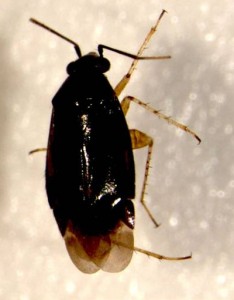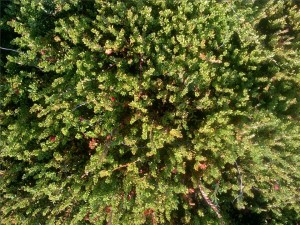This year we observed damage to cranberries likely caused by an unknown “mirid” bug (Hemiptera: Miridae). These insects are known as true bugs and have piercing-sucking mouthparts to suck juices out the plants. The species has now been identified by Dr. Thomas Henry, from USDA-ARS-Systematic Entomology Laboratory in Beltsville, MD, as Plagiognathus repetitus (Hemiptera: Miridae).
The insect seems to damage young leaf and flower buds. We observed deformed leaves and flowers in June. This damage appears to cause serious reduction in yield. The damage was likely caused by the nymphs in April-May, as adults were seen in June-July.We know little about the biology and management of this insect at this point. Mirids can be serious pests of other agricultural crops. For example, the tarnished plant bug, Lygus spp., is an important pest of cotton causing injury to the flowering buds. As for Plagiognathus repetitus, Franklin (1950) writes that in Massachusetts it overwinters as eggs and the eggs hatch in early June (my guess is that in New Jersey the eggs will start to hatch in May, so scouting for nymphs should start as soon as the water is removed from the beds) (Franklin H.J. 1950. Cranberry insects in Massachusetts. Massachusetts Agricultural Experiment Station Bulletin 445. 88 pp). Adults were seen in Massachusetts in late June-early July (similar to our observations). The insect is known to occur from Ontario (Canada) to Virginia and is an ericaceous plant specialist. It has been recorded form cranberry, sheep laurel, Vaccinium sp., and related plants (Wheeler, 1996, Banisteria 8: 52). Franklin noted that this insect is rarely seen in high numbers; this was not the case this year where we saw high numbers in one farm that had not sprayed broad-spectrum insecticides pre-bloom in several years.
At this point, we recommend growers to watch for this insect in early spring after removing the water from bogs. Carefully look for the nymphs in sweep net samples. If needed, use a broad-spectrum insecticide like Lorsban for its control. We will be updating growers on any progress we make towards learning more about this new pest.


